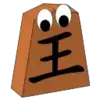#10 Even so, measuring complexity isn't quite as simple as measuring depth (or time/nodes, or hash table size). There are all kinds of factors which make a move difficult to find:
For example, engines with hash tables may find this simple:
http://chessprogramming.wikispaces.com/Corresponding+Squares
For example, engines with hash tables may find this simple:
http://chessprogramming.wikispaces.com/Corresponding+Squares


